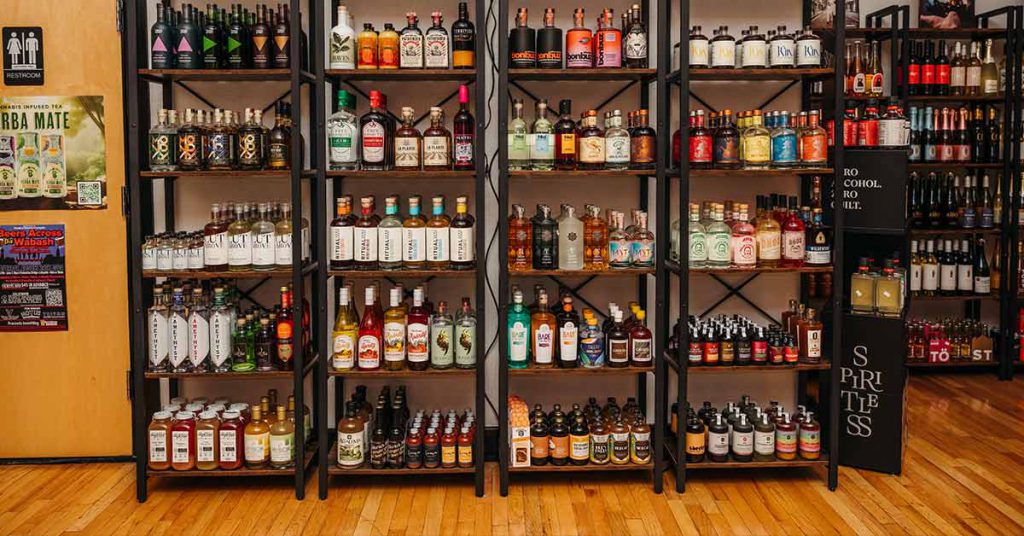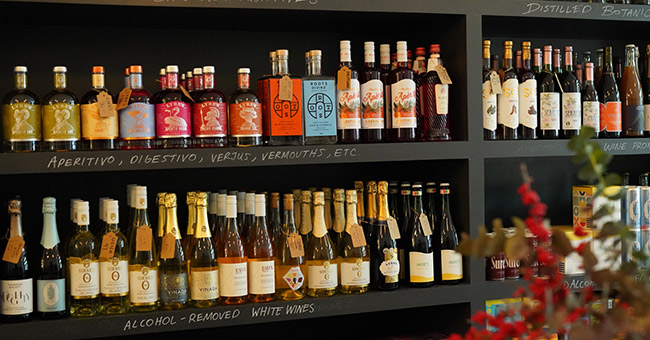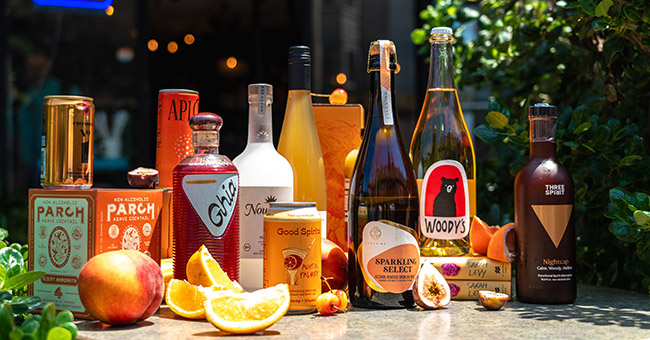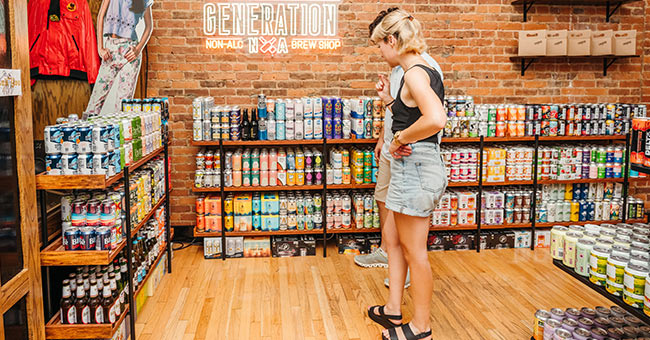
As Sober October kicks into gear, adult non-alcoholic (ANA) beverages are expected to have another strong month. But that popularity has shifted the competitive retail landscape as bigger players enter the space and price-conscious consumers hold back on expensive purchases.
Often the place where consumers are introduced to the wider category, ANA retailers are on the front lines of the movement and, in response to growing demand, are turning to experiential and community building strategies to keep consumers coming back for more.
No-alcohol beverages showed continued strength in 2023, with overall volumes rising 29% in the U.S. versus 2022, according to IWSR Drinks Market Analysis data.
Even as volumes drift higher, availability has become a concerning “long-term trend” and the biggest barrier to increased consumption, said Susie Goldspink, IWSR’s head of no- and low-alcohol insights, with 47% of no- to low-buyers in 2023 saying availability was a factor preventing more frequent consumption.
ANA beverages have made shelf gains in conventional and mass retailers, but there have also been some notable stumbles as well.
The high-profile closure and Chapter 11 bankruptcy of early adopter Boisson’s eight locations in April showed that brick-and-mortar retail can still be a tricky niche to fill.
Chicago-based NA retailer Bendición “started really strong” when it opened in October 2022, said founder Cristina Torres, but as more NA brands found shelf-space in large retail chains, her store struggled to retain customers. The store closed its Humboldt Park location in June and has moved exclusively to e-commerce.
Operating online has come with its own set of challenges from shipping costs and keeping inventory, but for Torres, the real challenge has been transitioning from face-to-face interactions to driving awareness through social platforms.
“I’m a millennial, but I’m not super tech savvy,” she said. “Finding the right target audience is really important because you can market as much as you want, but if you’re not getting in front of the right people, then it’s not going to really matter. I do think long term it is sustainable, I just need to find my group.”
One of the former founders of Boisson, Barrie Arnold, launched a new ecommerce platform last month. Bardelia aims to eventually make the jump to brick-and-mortar after building a community online.
“Consumers increasingly turn to the internet for product discovery and research, interacting with brands multiple times online before committing to a purchase,” Arnold said. “E-commerce platforms empower businesses like ours with a wealth of data – we get to know our customers and can offer tailored product recommendations and content to enhance their experience.”
This appears to be playing out in scanner data. New ANA shoppers are coming to the category from ecommerce channels and premium retailers, according to survey data from Numerator.

“Experiential Marketing”
That’s not to say the premium boutique bottle shop doesn’t still have a place in pushing the ANA category further into the mainstream.
In November 2020, Spirited Away opened in the Lower East Side neighborhood of Manhattan during the height of the pandemic. A year later, demand had grown so much that owner Douglas Watters moved a couple blocks over to the neighboring Nolita neighborhood.
Operating in a high-income area is important but “we pay for it in rent,” Watter said. “Retail is a difficult business. It’s expensive, probably more in terms of staffing than it is in some of the smaller markets.”
As the category matures and there is more understanding of ANA products, Watters’ team at Spirited Away has started to view the store as less of a retail concept rather than a “brand activation space.”
“It’s an IRL (in real life) experiential marketing opportunity,” he said. Brands pay to present at these “mini pop ups” in the store and, in turn, provide a secondary source of income for Spirited Away. The pop-ups also serve a purpose for customers familiar with a boutique alcoholic bottle shop experience: discovery.
Consumers find new products and can take part in the “consultative sales experience,” as Watters calls it, where they are both educated in the nuances of the category while also being pointed towards the right drink for their specific tastes or needs.
American consumers spend an average of $105 monthly on alcohol with $58 in retail and $47 at restaurants and on-premise locations, according to a survey by CPG advertising consultancy group NCSolutions. Bridging those two avenues in one location could prove to be a successful approach for many retailers.

Have A Drink And Stay Awhile
One opportunity that NA stores have is that they are not as tied to the same licensing laws that govern bev-alc retailers and can often offer on-premise consumption in the same place that ANA products are sold to-go.
This seemed like the most obvious answer to career bartender Joshua James, who opened Ocean Beach Café in San Francisco in January 2021.
“Everybody seems to want to open a [NA] bottle shop,” he said. “So you want to buy a bottle for $25 and try to sell it for $40? What if you took that bottle for $25 and you sold it for $225? That’s what the bar industry is, but if you don’t come from hospitality, why would you really be thinking of that.”
James’ approach to building his retail concept –café by day, bar by night – started with the name.
“I wasn’t going to go call it Niche Non-Alcoholic Bar, or Josh’s Non-Alcoholic Bar in the Outer Richmond of San Francisco. I would be doing less than a third of the revenue,” he said. “I called it Ocean Beach Café, so I get people in there with lattes and sandwiches which offer great margins.”
After “paying his dues” slinging sandwiches and steaming milk for lattes, James has created a hybrid concept that blends in the one of the most important things that people are looking for in the ANA category: acceptance.
Ocean Beach still offers a food menu and coffee drinks but it also has a curated selection of ANA drinks as well as other functional beverages coupled with a lounge-like atmosphere to socialize and relax.
With a steady customer base, James has turned his focus to brand-building where he is now importing Austrian NA wine Zeronimo under his Ocean Beach Brands company.
“For brand owners, the on-trade and direct-to-consumer channels present relatively untapped opportunities,” said IWSR head of U.S. operations Marten Lodewijks. “Brands can focus on expanding their presence in these to reach a wider audience.”

Targeting The Functional Consumer
This has also been the approach of Robert Theodorow at Generation NA in Lafayette, Ind. Like many other NA retailers, he came to the industry looking to reduce his alcohol intake as a result of the pandemic.
The shop’s location on the college town’s main street, just blocks from the Purdue University campus, brought a huge boon in organic walk-by traffic. But what really shifted the business to new levels of success was leaning into functionality over sobriety.
About three months ago, Theodorow changed the sign outside from “Non-Alcoholic Bottle Shop” to “Functional Bottle Shop” and there was an immediate boost in sales.
“It made it a lot more mainstream,” he said. “Everybody would come in and ask us what a functional drink is? It was a much more opportunist question. Rather than being on the defensive, why they should drink it, or am I evaluating or judging their drinking habits; they were asking me to tell them about kava and kanna.”
Now, Generation NA has between 300 and 500 people walking through its doors on Saturdays. That influx of people is one part location on the main walking street in town, one part proximity to a major university with a dedicated sports fan base and one part being an experiential anomaly in the Midwest. Not only does Generation NA have trouble keeping kava, CBD and hemp-derived THC drinks in stock but it has a retro pinball and video game machines that keep people coming back along with a small bar where they make adaptogenic slushies and pour from a tap.
Theodorow comes from a tech background but purposefully doesn’t have a website and only does local delivery through Doordash because “it’s all about the experience” of being at your local corner store, he said.
At the beginning of the year, Purdue’s student union came to Generation NA with an idea to develop a non-alc SKU in partnership with the university and local brewery People’s Brewing Company that launched last week to be offered at football and basketball games.
The strategy is all part of a cultural shift in how people interact socially that is being driven by millennial and Gen Z consumers.
“It has to do with the fabric of society, the fabric of our culture,” James said. “This whole non-alcoholic beverage market is about people drinking less but also getting towards developing how we connect with each other. This is absolutely the biggest subject of our time right now.”